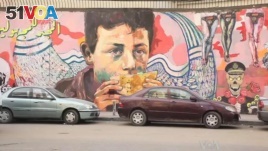January 24,2014
CAIRO — Since the 2011 uprising that overthrew Hosni Mubarak, Cairo’s exterior structures have become its canvas. On the third anniversary of that Egyptian Revolution, graffiti has exploded across the country, with Egyptian artists using their city’s walls to express everything from calls to revolution to outrage over sexual harassment.

Mohammad Mahmoud Street is a showcase of Egyptian street art. Politics. Social justice. Mourning. This is where Egyptian artists come to speak their minds.
The artist Ganzeer has painted some of the most iconic artworks of the revolution, including one on Mohammad Mahmoud. "You have these skulls and, in the midst of the skulls, you have one of the protest signs that was freedom, social justice, right there and a pile of skulls, and who’s responsible? Just a soldier, you know. It’s not Mubarak, it’s not the officer, ranks and whatever; it’s not the people who are making the decisions. It’s just a soldier following orders," he said.
Political battlefield
Over the years, the city’s walls have become a political battlefield where the artists are the soldiers.
In 2011, Ganzeer painted a tank pointing its cannon at a lone boy delivering bread on a bicycle.
After dozens of protesters were run over by tanks, a new addition was made to Ganzeer’s piece. But a pro-military group, unhappy with this portrayal, erased the dead and added Egyptian flags to the hands of the protesters. Anti-military artists returned fire by adding a military monster eating a protester.
Not all graffiti has been political. A group called the Mona Lisa Brigades works on issues of social justice in the impoverished neighborhood of Arda Lowa.
Drawing attention
Artist Ismail Mohammed said, "The goal of the project is to take photos of the children and write their dreams and write their names. So when the children are going round the street and seeing their photos in the street, when they are going to school and coming back from school... they are proud of what they want to be and proud of the place.
Mia Grondahl, a Swedish journalist and author, said most street art is aimed at getting attention in downtown Cairo, not at engaging the country’s poor.
"What the Mona Lisa Brigades are doing is, actually they are bringing up these people to the walls. Lifting them up. Showing them. Here they are. These are the people. Look at them. Take care of them. Listen to them. Hear them out. I would say that that is really revolutionary," said Grondahl.
Mira Shahada concentrates on issues of sexual harassment, but she feels her pieces have done little to change things. "The fight that’s in everyone is still there. Like it hasn’t changed. The thing that I believe we should be fighting for hasn’t changed. It’s about being uncompromising. And, if you’re an uncompromising type, these are difficult times to live through.
With the Egyptian military back in power, her fellow artist, Ganzeer, feels similarly.
"It’s kind of gone full circle. I could do the tank versus biker now and it would totally apply," he said. "Even the piece I did in Mohammad Mahmoud with the soldier and the skulls is actually based on a poster I designed back in 2011...So in a way things have changed, deceivingly changed. You think they change, but actually you’re back to square one again."